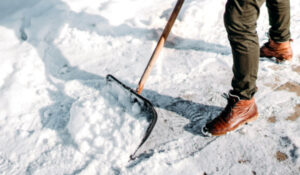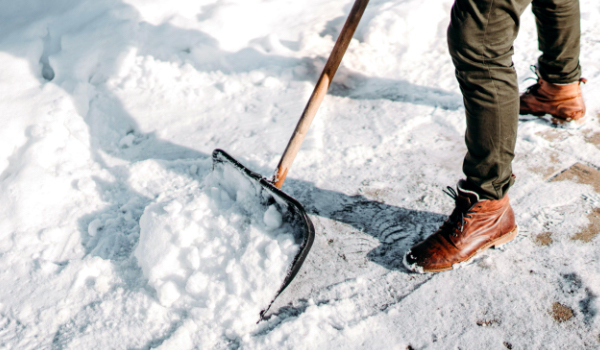Snow removal is the act of clearing snow. It’s usually done on a larger scale by cities. They dispatch teams immediately when a snow forecast is made. The first to hit the roads are gritters who plow and spread salt. The salt lowers the freezing point of the snow and ice and gives vehicles more traction. Check out Vantaoutdoors to learn more.
Winged Blade Plow
The winged blade plow is an ideal solution for snow removal teams who need to be as efficient as possible with their time and equipment. This type of plow features individual, hydraulically controlled wings that extend outward from the blade for increased scooping capacity. The wings can be extended or retracted at the touch of a button in the cab, and they help users move more snow in a single pass.
With a simple operation and straightforward design, winged blades are easy for all levels of snow removal operators to use. They also feature fewer moving parts than other blade styles, making them less likely to break or become damaged. They are best suited for residential snow removal, clearing driveways, and small properties.
Fully hydraulic-controlled wings allow users to angle the wing for windrowing, which helps reduce spill off and allows for a full pass with minimal blade overlap. They can also be positioned to scoop for greater efficiency in large parking lots or areas with lots of obstacles like cities.
If you’re looking for a versatile plow to improve your operations, the Henderson Extendable Wing is an excellent choice. This wing takes up less chassis frame rail and tucks back for easier, more compact storage. It’s an affordable, effective way to increase the reach of your snowplow with a quick and easy install.
To get the most out of your winged plow, it’s important to know how to use it properly. Start by evaluating the types of snow your area typically receives and creating a plan for clearing those spaces before each storm hits. This will help you avoid damage to your equipment and make the most of your plow’s capabilities.
Once you have your plan in place, take some time to practice and learn how to operate your new plow. This will save you time and money in the long run and ensure your crew is ready to go when the first snowfall arrives. Before the season starts, take pictures of key areas and put up signs to mark them for drivers. This will help you reduce the risk of damaging lighting, signs, and other outdoor decorations near your property.
V-Plow
A V-plow is one of the more versatile options for snow removal. It is often mounted on a motor grader, and contractors like it because of its ability to plow in long stretches of road without losing power or efficiency. If you choose this option, be sure to select the correct blade width and add a plow shoe kit to improve your results. These are available at The Rugged U and will improve your scrape by providing a cleaner surface when back-dragging the plow.
You can also add a box plow to your truck for snow removal, but be sure to check the vehicle’s GAWR (gross axle weight rating) and the payload capacity of the plow. This will ensure your vehicle can handle the load of snow and provide ice control for roads, highways and parking lots.
For driveways, choose the V-position for your first pass and the scoop or angle position for widening the lane. When using the V-position, a good rule of thumb is to use the full blade width for snow two inches thick or less; three quarters for four inches or more; and half the blade for six inches or more. Be careful not to overload your equipment; if you are pushing too much snow, it can damage your plow and your vehicle.
Some operators prefer to use the V-plow in the scoop position to break up large piles of snow or to move snow around. They can also pierce the snow with the blades angled forward, a technique called windrowing that helps clear snow quickly.
A v-plow is also ideal for clearing commercial and retail parking lots. It can be positioned in the scoop, V or angle position and is often used with the snow wings lowered for maximum versatility.
A v-plow can cut your plowing time in half compared to a straight blade, says Snow Magazine. When choosing a v-plow, look for a system that is simple to operate and can be easily modified by the operator according to conditions. The last thing you want is to lose productivity because of a hard-to-use plow.
Snowplow Attachment
The snowplow attachment is used to push, scoop, stack, and back drag snow to complete a variety of winter tasks. It’s available in a variety of widths and comes with steel or rubber edges that work well with the surface type and conditions. It’s mounted further back from the cab than other types of snow removal attachments, offering ideal visibility and maximizing efficiency.
A plow requires a hydraulic system that uses pressurized oil to raise, lower, and angle the blades. It also provides power to float the blades across the ground for better performance. To prevent damage to the plow and loader, it’s recommended that a plow blade not be used with terrain or surface types that exceed its operating capabilities.
It’s a good idea to have a snowplow on hand in case you need to do a quick pick-up or move a pile of snow, especially for emergency situations that can’t wait for a snow removal contractor. You can also use it to plow out parking lots, sidewalks, roads, and driveways with ease, which helps keep business running smoothly during inclement weather.
There are many different snow and material removal attachments available for skid steers, making it easy to outfit your equipment with what you need before winter arrives. Considering the size of your space, your preferred attachments, and how you’ll be using your skid steer will help you choose the right snow attachments for your needs.
To avoid damaging your equipment, be sure to re-rig your machine after each use. If you plan on using your loader for other tasks such as salt and sand loading, consider an attachment that mounts a plow blade directly onto it to keep it ready for the next time snow falls. This way, you won’t have to re-rig your skid steer for each snow clearing job. It can save you time, money and effort in the long run. In addition, it’ll be much easier to switch between attachments in the event you have to clear an obstacle or a change in surface type during a snow removal job.
